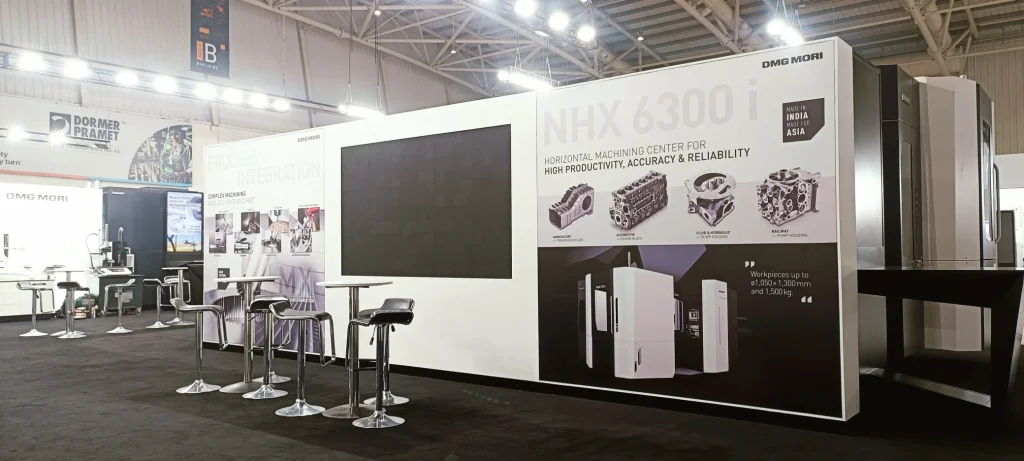
Introduction:
Lighting plays a crucial role in trade show booth design, not only in illuminating the physical space but also in enhancing brand visibility, creating ambiance, and drawing attendees’ attention.
By strategically leveraging lighting techniques, exhibitors can effectively showcase their brand message, products, and services while creating a memorable and engaging experience for attendees. In this blog, we’ll explore the importance of lighting in trade show booth design and discuss how it can be used to illuminate your brand message.
1. Setting the Mood:
- Lighting sets the mood and ambiance of the trade show booth, influencing attendees’ emotions and perceptions.
- Warm, soft lighting creates a welcoming and inviting atmosphere, encouraging attendees to enter the booth and engage with its offerings.
- Cool, bright lighting conveys a sense of professionalism and modernity, aligning with brands that emphasize innovation and cutting edge solutions.
2. Highlighting Key Elements:
- Lighting directs attendees’ attention and highlights key elements of the booth, such as product displays, signage, and branding.
- Spotlighting can be used to draw attention to specific products or features, creating focal points within the booth.
- Backlighting or uplighting can be employed to illuminate branding elements, logos, and graphics, making them stand out and reinforcing brand visibility.
3. Creating Depth and Dimension:
- Lighting adds depth and dimension to the trade show booth, enhancing its visual appeal and creating a dynamic environment.
- Use lighting techniques such as wash lighting, accent lighting, and shadowing to create depth and texture within the booth.
- Play with light and shadow to create visual interest and draw attendees’ gaze toward key areas or displays.
4. Enhancing Brand Identity:
- Lighting can be used to reinforce and enhance the exhibitor’s brand identity and messaging.
- Incorporate brand colors into lighting fixtures, LED displays, or projection mapping to create a cohesive and immersive brand experience.
- Use lighting effects to evoke emotions and associations that align with the brand’s values, personality, and positioning in the market.
5. Differentiating from Competitors:
- Lighting can be a powerful tool for differentiating the trade show booth from competitors and capturing attendees’ attention in a crowded exhibition hall.
- Experiment with unique lighting effects, such as color changing LEDs, dynamic patterns, or interactive displays, to create a memorable and distinctive booth experience.
- Incorporate motion and movement into lighting designs to create a sense of energy and excitement, attracting attendees from across the trade show floor.
6. Maximizing Visibility and Impact:
- Proper lighting ensures that the trade show booth is visible and impactful, even from a distance.
- Use bright, focused lighting to ensure that signage and branding elements are easily readable and recognizable from afar.
- Consider the overall lighting conditions of the trade show venue and adjust lighting levels accordingly to maximize visibility and impact.
7. Creating Atmosphere and Experience:
- Lighting plays a significant role in creating a specific atmosphere and experience within the trade show booth.
- Dynamic lighting effects, such as color changing LEDs or programmable light sequences, can transform the mood and ambiance of the booth throughout the day.
- Tailor lighting schemes to match the theme or concept of the booth, whether it’s a sleek and modern aesthetic or a cozy and intimate setting.
- Incorporate lighting controls that allow exhibitors to adjust brightness, color, and intensity to create different atmospheres for different times of day or types of interactions.
8. Guiding Attendees’ Journey:
- Lighting can serve as a subtle guide to direct attendees’ journey through the trade show booth.
- Use lighting cues to delineate pathways, highlight entrances, and indicate points of interest or interactive experiences.
- Incorporate directional lighting or lighted signage to help attendees navigate the booth space and discover key elements or attractions.
9. Leveraging Contrast and Focus:
- Contrast and focus created by lighting can draw attention to specific areas or features within the trade show booth.
- Use lighting contrasts, such as spotlighting against a dark background or backlighting against a bright surface, to create visual interest and drama.
- Highlight important product displays, demo areas, or branding elements with focused lighting to ensure they stand out amidst the booth’s visual landscape.
10. Energy Efficiency and Sustainability:
- In addition to aesthetics and functionality, exhibitors should also consider the energy efficiency and sustainability of lighting solutions.
- Opt for energy efficient LED lighting fixtures that consume less power and have a longer lifespan, reducing energy costs and environmental impact.
- Incorporate lighting controls and automation systems that allow for precise management of lighting levels and schedules, optimizing energy usage and minimizing waste.
- Choose lighting materials and technologies that are eco friendly and recyclable, aligning with sustainable practices and corporate responsibility initiatives.
11. Interactive Lighting Installations:
- Interactive lighting installations can create immersive experiences that captivate attendees and leave a lasting impression.
- Incorporate motion sensors, touch sensitive panels, or interactive projections that respond to attendees’ movements or interactions.
- Create gamified experiences or interactive challenges that encourage attendees to engage with the booth and explore its offerings in a fun and memorable way.
- Use lighting effects to dynamically respond to attendee actions or inputs, creating a sense of interactivity and personalization.
Conclusion:
The impact of lighting in trade show booth design extends far beyond mere illumination; it shapes the atmosphere, guides attendee interactions, and enhances brand experiences. By strategically leveraging lighting to create atmosphere and experience, guide attendees’ journey, leverage contrast and focus, prioritize energy efficiency and sustainability, and incorporate interactive installations, exhibitors can create immersive, memorable, and impactful booth experiences that captivate attendees and drive desired outcomes. By investing in innovative lighting solutions and creative design strategies, exhibitors can elevate their booth presence, differentiate from competitors, and leave a lasting impression on trade show attendees.


 US
US
 EU
EU


